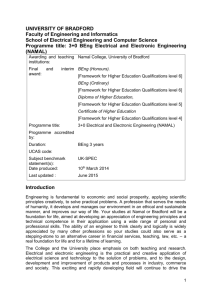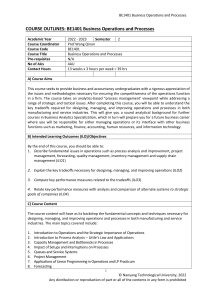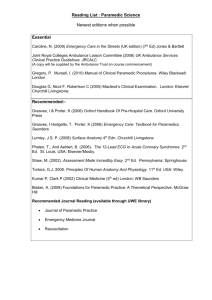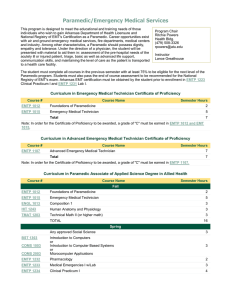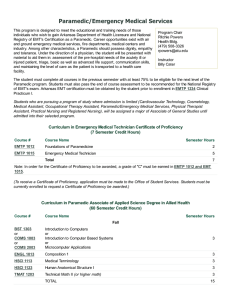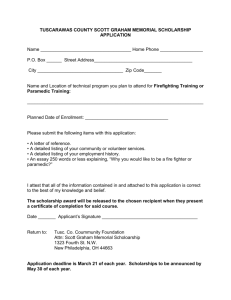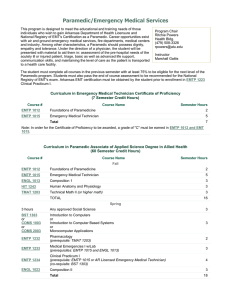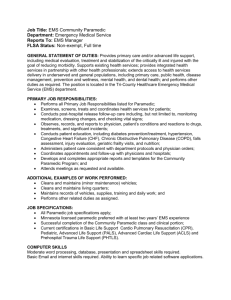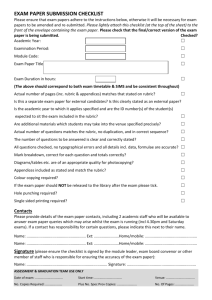Paramedic PLOs Fall 11 - Imperial Valley College
advertisement
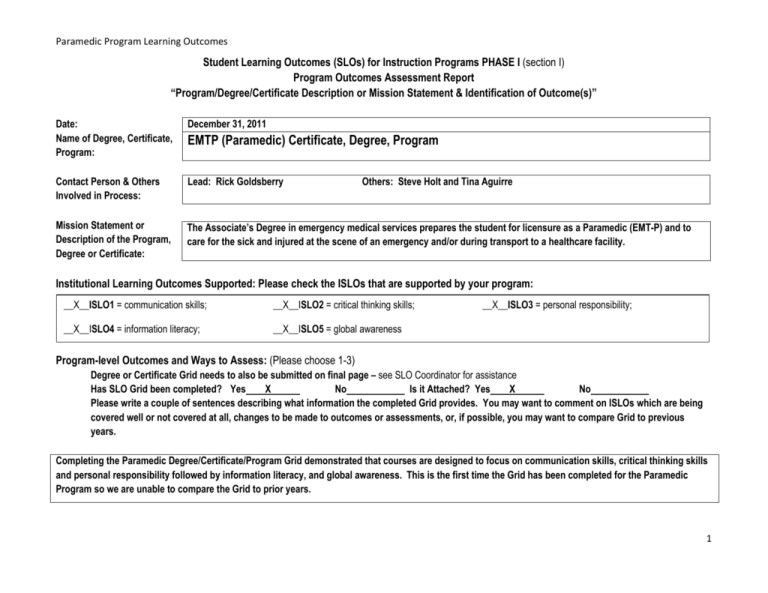
Paramedic Program Learning Outcomes Student Learning Outcomes (SLOs) for Instruction Programs PHASE I (section I) Program Outcomes Assessment Report “Program/Degree/Certificate Description or Mission Statement & Identification of Outcome(s)” Date: Name of Degree, Certificate, Program: December 31, 2011 Contact Person & Others Involved in Process: Lead: Rick Goldsberry Mission Statement or Description of the Program, Degree or Certificate: The Associate’s Degree in emergency medical services prepares the student for licensure as a Paramedic (EMT-P) and to care for the sick and injured at the scene of an emergency and/or during transport to a healthcare facility. EMTP (Paramedic) Certificate, Degree, Program Others: Steve Holt and Tina Aguirre Institutional Learning Outcomes Supported: Please check the ISLOs that are supported by your program: __X__ISLO1 = communication skills; __X__ISLO2 = critical thinking skills; __X__ISLO4 = information literacy; __X__ISLO5 = global awareness __X__ISLO3 = personal responsibility; Program-level Outcomes and Ways to Assess: (Please choose 1-3) Degree or Certificate Grid needs to also be submitted on final page – see SLO Coordinator for assistance Has SLO Grid been completed? Yes X No Is it Attached? Yes X No Please write a couple of sentences describing what information the completed Grid provides. You may want to comment on ISLOs which are being covered well or not covered at all, changes to be made to outcomes or assessments, or, if possible, you may want to compare Grid to previous years. Completing the Paramedic Degree/Certificate/Program Grid demonstrated that courses are designed to focus on communication skills, critical thinking skills and personal responsibility followed by information literacy, and global awareness. This is the first time the Grid has been completed for the Paramedic Program so we are unable to compare the Grid to prior years. 1 Paramedic Program Learning Outcomes Please include the outcomes that have been designed for your courses. Course # BUS 132 BUS 136 EMTP 200 EMTP 210 EMTP 215 EMTP 225 EMTP 235 Outcomes 1. Successfully conclude a negotiation.(ILO1, ILO2, ILO3, ILO5) 2. Demonstrate an ability to productively work as a team member with people of diverse experiences and backgrounds by exchanging ideas and viewpoints with other team members to develop a united position for negotiating a solution to a common business problem as posed in a negotiation scenario. (ILO1, ILO2, ILO3, ILO5) 3. Identify and define the four functions of management and describe how each element applies to managers in a typical business environment. (ILO1, ILO2, ILO3, ILO5) 4. Identify and define the steps of the managerial decision-making process and follow the steps to make a decision in a simulated business case. (ILO1, ILO2, ILO3, ILO5) 1. Describe different employee attitudes and analyze the consequences of those attitudes on a business. (ILO1, ILO2, ILO3, ILO5) 2. Explain the importance of interpersonal dynamics by applying the Gung Ho! approach. (ILO1, ILO2, ILO3, ILO4, ILO5) 3. Apply human relations techniques in their workplace and personal lives.(ILO1, ILO2, ILO3, 1. Perform in the role of Basic Life Support Instructor according to the guidelines of the American Heart Association. (ILO1, ILO5) 2. Demonstrate competent trauma victim assessments and resuscitation as measured using two observer evaluations during simulated scenario practice. (ISLO1, ISLO2, ISLO3,ISLO4, ISLO5) 3. Progress to competent professional behavior as measured by the Global Affective Professional Behavior Evaluation. (ISLO1, ISLO3, ISLO5) 1. Assessment and treatment of medical problems including cardiac patients as measured by using two observer evaluations during simulations. ILO2, ILO3 2. Demonstration of entry level skills attainment as measured by passing a skills check-off using matrix. ILO2, ILO3, 3. Professional behavior competency as measured by Global Affective Professional Behavior evaluation matrix. (ISLO1, ISLO3, ISLO5) 1. Demonstrate competency in the cognitive and practical skills requirement to successfully complete the Advance Cardiovascular Life Support(ACLS) Provider Course ISLO1, ISLO2, ISLO3, ISLO4 2. Demonstrate competency in the cognitive and practical skills requirement to successfully complete the Pediatric Advanced Life Support (PALS) Provider Course ISLO1, ISLO2, ISLO3, ISLO4 3. Demonstrate competency in areas of professional behaviors. Instructor evaluation of student using Global Affective Professional Behavior Evaluation Rubric 1. Demonstrate competencies in paramedic clinical skills at an entry level as measured by instructor observation in the clinical setting and daily skills evaluation using a grading rubric. ISLO1. ISLO2, ISLO3, ISLO5 2. Do entry level patient assessment of live patients in a clinical setting. Evaluation using patient assessment rubric by clinical preceptors of a minimum number of patients assessed. ILO2, ILO3 3. Develop competence in professional behaviors using Global Affective Professional Behavior Evaluation rubric. (ISLO1, ISLO3, ISLO5) 1. Thoroughly assess, provide care, communicate with patients, and relay appropriate information to the station as determined by the field preceptor during live and simulated situations and measured by field evaluation grading rubric. ILO2, ILO3 2. Successfully pass all instructor/program director evaluations of practice based on field grading evaluation rubric every 5th shift. ILO2, ILO3 3. Successfully pass the evaluation of competencies of professional behavior using the Global Affective Professional Behavior Evaluation rubric. (ISLO1, ISLO3, ISLO5) 2 Paramedic Program Learning Outcomes EMTP 245 1. Thoroughly assess, provide care, communicate with patients, and efficiently relate information to the station according to the evaluation rubric completed by field preceptors. ILO2, ILO3 2. Successfully pass all field evaluations by the instructor/program director based on the grading standards and evaluation rubric for entry-level paramedics (done every 5th shift while in the field). ILO2, ILO3 3. Successfully pass all entry level competencies for professional behavior using the Global Affective Professional Behavior Evaluation rubric. (ISLO1, ISLO3, ISLO5) Please identify at least one outcome and assessment method, and estimated date for the completion of Section II. Please keep in mind the Comprehensive Program Review Schedule. Instructional Programs (degrees, certificates): You are asked to complete Course-level Outcomes & Assessments for the two and half years leading up to your Program Review due date, and then Program-level Outcomes can be assessed during your Program Review Fall Semester. Still, even if your Program Review isn’t due this fall, you will want to make a plan to evaluate it with colleagues by your Program Review due date. 1.Outcome #1: Students meet or exceed pass rates set for national licensing exam (National Registry). Est. Completion Date: Within 4 months of program completion Way(s) to assess: NREMTP official reporting. 2.Outcome #2: Students meet or exceed pass rates set for national licensing skills exam (National Registry). Est. Completion Date: Prior to 3rd (fall) semester completion Way(s) to assess: NREMTP official scoring/reporting 3.Outcome #3: Students meet the minimal certification standards for ACLS, PALS, and BLS Instructor. Est. Completion Date: By completion of 1st (spring) semester. Way(s) to assess: Submission of appropriate AHA cards Once Section I is completed, please send e-copy & mail hard copy to SLO Coordinator. Then at the end of the data collection/assessment period, please analyze data with co-workers and other members of the IVC community, and complete Section II. 3 Paramedic Program Learning Outcomes Student Learning Outcomes for Instruction – PHASE II (section II) Program Outcomes Assessment Report “Assessment of Program-level Learning Outcomes” In this section, please re-state each outcome and indicate the method(s) of assessment, provide a summary of the results, and tell how your program will use this information to improve student learning. Each Goal should have at least one Method of Assessment. To encourage collaboration and the sharing of ideas, you are encouraged to share your outcomes, assessment data, and findings with all available members of your department or program. Please list the names of all faculty, staff, and students who were involved in summarizing or evaluating the data. The names may differ from those on Section I. Date: Contact Person/Others Involved in Process: Lead: Rick Goldsberry Others: Steve Holt and Justina Aguirre Outcome #1 (please repeat here: Students meet or exceed pass rates set for national licensing exam (National Registry). Est. Completion Date: Within 4 months of program completion Way(s) to assess: NREMTP official reporting. 1. First Method of Assessment: a. How did you assess Outcome #1? NREMTP official reporting b. Provide a summary of results: c. How will your program use this information to improve student learning? If curriculum changes will be made (i.e. course outline, course description, course activities), please explain. d. What is your Timeline for Program Modifications or Response to Data? Outcome # 2 (please repeat here): Students meet or exceed pass rates set for national licensing skills exam (National Registry). Est. Completion Date: Prior to 3rd (fall) semester completion Way(s) to assess: NREMTP official scoring/reporting 1. First Method of Assessment: a. How did you assess Outcome # 2? NREMTP official reporting b. Provide a summary of results: c. How will your program use this information to improve student learning? If curriculum changes will be made (i.e. course outline, course description, course activities), please explain. d. What is your Timeline for Program Modifications or Response to Data? 4 Paramedic Program Learning Outcomes Outcome # 3 (please repeat here): Demonstrate skills needed to meet the minimal certification standards for BLS and ACLS. Est. Completion Date: By completion of 1st (spring) semester. Way(s) to assess: Submission of appropriate AHA cards 1. First Method of Assessment: a. How did you assess Outcome # 3? b. Provide a summary of results: c. How will your program use this information to improve student learning? If curriculum changes will be made (i.e. course outline, course description, course activities), please explain. d. What is your Timeline for Program Modifications or Response to Data? 2. Second Method of Assessment: a. How did you assess Outcome # 3? b. Provide a summary of results: c. How will your program use this information to improve student learning? If curriculum changes will be made (i.e. course outline, course description, course activities), please explain. d. What is your Timeline for Program Modifications or Response to Data? 5 Paramedic Program Learning Outcomes Program Outcomes and Course Alignment Grid for Imperial Valley College Program: Emergency Medical Services Certificate, Degree, & Program Prepared by : Justina Aguirre and Rick Goldsberry Course Communication Critical Thinking Personal Responsibility Completed on: Information Literacy Dec 31, 2011 Global Awareness BUS 132 3 3 1 3 1 BUS 136 3 3 3 3 3 EMTP 200 3 3 3 3 3 EMTP 210 2 3 3 1 1 EMTP 215 3 3 3 3 1 EMTP 225 3 3 3 2 3 EMTP 235 3 3 3 1 3 EMTP 245 3 3 3 1 3 **FIVE POINT KEY: Using this key, to receive a 3 or 4 the ISLO needs to be measured through the outcome and assessment. 4= This is a STRONG focus of the course. Students are tested on it or must otherwise demonstrate their competence in this area. 3= This is a focus of the course that will be assessed. 2= This is a focus of the course, but is NOT assessed. 1= This is briefly introduced in the course, but not assessed. 0= This is not an area touched on in the course. # of Outcomes identified so far for course 3 3 3 3 3 3 3 3 6
